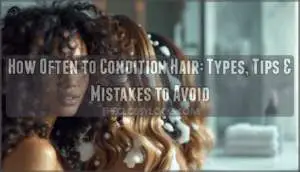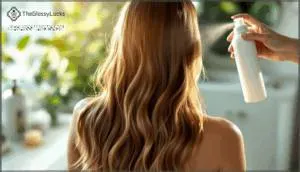This site is supported by our readers. We may earn a commission, at no cost to you, if you purchase through links.

Over 65% of women use rinse-out conditioner regularly, but many are guessing at frequency rather than matching it to their hair’s actual needs. Understanding the different types of conditioners and how often your specific hair type requires each one prevents common mistakes that lead to buildup, breakage, or dryness.
Table Of Contents
- Key Takeaways
- Frequency of Rinse-out Conditioner
- Benefits of Leave-in Conditioner
- How to Use Deep Conditioner
- Benefits of Cleansing Conditioner
- Tips for Effective Deep Conditioning
- Common Conditioner Mistakes to Avoid
- Frequently Asked Questions (FAQs)
- What types of conditioner are available?
- What ingredients are usually found in conditioner?
- What are the benefits of using conditioner?
- How should I apply conditioner for best results?
- Can I condition hair without shampooing first?
- What ingredients should I avoid in conditioner?
- Does conditioner help with hair growth rate?
- Should I condition my scalp or roots?
- How long does conditioner take to work?
- Conclusion
Key Takeaways
- Rinse-out conditioner works best two to four times weekly, but your specific schedule depends on your hair type—fine or oily hair needs conditioning every three days to avoid buildup, while dry, curly, or color-treated hair benefits from more frequent application to maintain moisture and control frizz.
- Applying conditioner to your scalp or roots causes greasiness and reduces volume by 28% in fine hair, so focus product from mid-lengths to ends where damage accumulates, and rinse thoroughly for one to five minutes to avoid either reduced effectiveness or product buildup.
- Deep conditioning treatments require 20 to 30 minutes with heat application to open cuticles and boost ingredient penetration by up to 50%, making monthly treatments essential for repairing damaged strands when you target mid-lengths and ends.
- Cleansing conditioner (co-washing) preserves 60% more of your scalp’s natural oils than traditional shampoo while increasing moisture content by 65% and slowing color fading by 35%, making it ideal for curly, color-treated, or sensitive scalps.
Frequency of Rinse-out Conditioner
As a rule, rinse-out conditioner should be used two to four times weekly, though hair type and your hair care routine dictate the ideal frequency. If you have fine or oily hair, conditioning once every three days prevents buildup and greasiness. Dry, curly, or color-treated hair benefits from more frequent application—potentially with every wash—to lock in hair moisture and manage frizz.
Application methods matter: focus product from mid-lengths to ends, massaging thoroughly before rinsing with approximately six liters of water.
Market trends show that over 65% of women integrate rinse-out conditioner into their routine, making it the most popular hair conditioning frequency choice across demographics. Data from 2017 shows conditioner usage statistics vary considerably.
Benefits of Leave-in Conditioner
Leave-in conditioner offers a hydration boost that protects your hair between washes. Unlike rinse-out formulas, it stays active throughout the day, delivering continuous frizz control and detangling ease. Your hair routine becomes simpler when you apply it to damp strands after washing—focusing on mid-lengths to ends. These products also provide UV protection, shielding color-treated or chemically processed hair from sun damage. Leave-in conditioners can also help with environmental damage protection.
Consider these hair benefits:
- Locks in hair moisture for up to 24 hours
- Smooths cuticles to reduce breakage during styling
- Acts as a styling aid under heat tools
- Repairs split ends with targeted conditioning
- Maintains manageability in humid conditions
Apply leave-in conditioner weekly for normal hair or daily for severely dry textures, following hair conditioning tips specific to your type.
How to Use Deep Conditioner
Deep conditioner works best when you apply it to freshly washed, towel-dried hair and let it sit for at least 20 to 30 minutes. The benefits of deep conditioning multiply when you use heat—wrap your hair in a warm towel or sit under a hooded dryer to help ingredients penetrate the cuticle. Focus applying conditioner techniques on your mid-lengths and ends where damage accumulates. For DIY recipes, mix coconut oil with honey for natural ingredient benefits.
Try these deep conditioning treatments monthly:
- Apply product generously, sectioning hair for even coverage
- Use a processing cap to trap heat and boost absorption
- Rinse timing matters—lukewarm water seals the cuticle without stripping moisture
Benefits of Cleansing Conditioner
Cleansing conditioner simplifies your hair care routine by combining gentle cleansing with moisture retention in one step. This cowashing method removes buildup without stripping your scalp’s natural oils, maintaining 60% more of your protective lipid barrier than traditional shampoo. You’ll notice softer hair and reduced frizz, especially if you have curly or color-treated hair. Co-washing slows color fading by 35% and increases moisture content by up to 65%. The mild surfactants decrease scalp irritation by 55%, making this approach ideal for sensitive scalps.
Market trends show a growing demand, with the global cleansing conditioner market reaching $1.34 billion in 2024 as more people discover these benefits for their specific hair type.
| Benefit | Impact |
|---|---|
| Gentle Cleansing | 55% less scalp irritation |
| Moisture Retention | 65% increased hydration |
| Oil Preservation | 60% better lipid protection |
| Color Protection | 35% slower fading |
Tips for Effective Deep Conditioning
Proper technique can boost your deep conditioning results by up to 50%, turning a routine treatment into a genuine hair rescue mission. Start by applying your deep conditioner to freshly washed, damp hair—not soaking wet. Excess water dilutes the product and reduces its effectiveness. Focus on the mid-lengths to ends where damage usually accumulates.
Heat application amplifies penetration. Wrap your hair in a warm towel or use a heat cap for 20-30 minutes. The warmth opens your hair cuticles, allowing conditioning agents to reach deeper into each strand.
Four steps that transform damaged hair:
- Section hair into four parts for even distribution
- Apply product generously from mid-shaft down
- Gently detangle with a
Common Conditioner Mistakes to Avoid
Even though conditioner seems straightforward, small mistakes can sabotage your hair care routine. Scalp application is the most common error—63% of people apply conditioner from root to tip, causing oiliness and a 28% volume reduction in fine hair. The wrong type matters too: mismatched formulas increase limpness by 39% in fine-haired individuals, while curl-enhancing versions improve definition by 77% for wavy or curly textures.
Most conditioner mistakes—like applying to roots or using the wrong formula—reduce volume by 28% and worsen hair issues despite seeming harmless
Rinsing duration affects results more than you’d think. 68% of users rinse too quickly (under 1 minute) or leave conditioner on excessively (over 10 minutes), missing the ideal 1–5 minute window. Quick rinsing cuts smoothing effects by 36%, while prolonged exposure increases product buildup by 19%.
Uneven distribution leaves 54% of users with inconsistent hydration—untreated sections show 18% more dryness and split ends. Inadequate rinsing creates scalp residue in 37% of cases, dulling hair and reducing body by 15%.
| Mistake | Impact |
|---|---|
| Overconditioning hair | Greasiness, flat roots, styling difficulty |
| Underconditioning hair | Dryness, breakage, frizz, split ends |
| Product buildup | Dull appearance, scalp irritation, hair damage |
Frequently Asked Questions (FAQs)
What types of conditioner are available?
There’s a conditioner for every hair concern—you just need to know which one fits yours. Rinse-out conditioner is your everyday option, applied after shampooing and rinsed out within minutes. Leave-in conditioner stays in your hair until the next wash, offering continuous moisture. Deep conditioner penetrates deeply and sits for 30 minutes or more to repair damage. Cleansing conditioner washes and conditions simultaneously, skipping shampoo altogether.
Cream conditioners work best for damaged, dry hair. Oil conditioners and spray conditioners suit thick or oily hair types. Each conditioner type uses different ingredients suited to specific hair needs.
What ingredients are usually found in conditioner?
Most conditioners rely on cationic surfactants to smooth the hair cuticle, while emollients and oils restore moisture.
Silicones add shine and protect against heat, and proteins strengthen damaged strands for healthier-looking hair.
What are the benefits of using conditioner?
Why settle for dry, lifeless strands when conditioner offers so much more? Using the right conditioner delivers hydration benefits while preventing damage and adding shine.
It boosts manageability, protects against breakage, and locks in hair moisture for healthier strands. Regular hair conditioning benefits include frizz control and improved hair health.
How should I apply conditioner for best results?
Focus on application techniques that match your hair type. For fine or oily hair, apply conditioner from mid-lengths to ends only.
If you have dry, coarse, or curly hair, work it through all sections for better product distribution. Rinse thoroughly after two to three minutes.
Can I condition hair without shampooing first?
Yes, you can—this practice is called co-washing. Cleansing conditioners clean and moisturize simultaneously, making shampooing optional.
Co-washing benefits curly or dry hair types by preserving natural oils while removing product buildup. Choose conditioner ingredients suited to your scalp health and hair care routine needs.
What ingredients should I avoid in conditioner?
Pay attention to p
Does conditioner help with hair growth rate?
Conditioner doesn’t directly speed up hair growth, but it creates the right conditions for healthy growth.
By improving Scalp Health, preventing Reduced Breakage, and boosting Hair Strength through Hydration Benefits and Nutrient Absorption, proper hair conditioning tips support your hair’s natural growth cycle.
Should I condition my scalp or roots?
You’ll want to skip
How long does conditioner take to work?
Rinse-out conditioner generally works in one to three minutes, while leave-in formulas absorb gradually throughout the day.
Deep conditioning treatments need 30 minutes or longer for visible results and proper hair shaft penetration.
Conclusion
The strangest coincidence in hair care? The same people who research car maintenance schedules for hours often wing their conditioning routine entirely. Your hair’s needs shift with seasons, treatments, and even stress levels, so how often to condition hair isn’t a decision you make once and forget.
Check your strands regularly. If they feel dry mid-shaft or tangle easily, increase frequency. If roots look flat by noon, pull back. You’re not following a chart—you’re listening to what your hair tells you.







